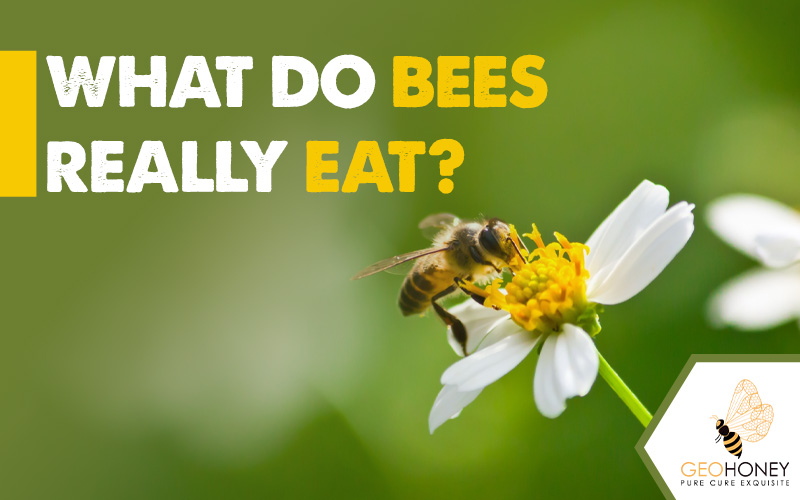- Tokyo: 14:01
- Singapore: 13:01
- Dubai: 09:01
- London: 05:01
- New York: 00:01
What Do Bees Really Eat?

Ever wondered what bees really eat to produce such sweet honey? After all, diet directly affects everything, from brood health and honey production to colony strength. It even impacts overwintering survival.
So, let’s get into what bees really eat, how it changes depending on their stage in life, and what that means for you.
Nectar and Pollen: The Key in a Bee’s Diet
Nectar and pollen are at the core of every bee’s meal plan.
Nectar = Energy Source
Nectar is a sugary liquid produced by flowers. Rich in carbohydrates, it is the fuel bees need for flight, foraging, and maintaining hive warmth. Once collected, bees convert nectar into honey through a fascinating process of regurgitation, evaporation, and fermentation.
This honey becomes their long-term energy reserve. Especially vital during winter or dearth periods when fresh nectar isn’t available.
Pollen = Protein Source
Pollen is the protein powerhouse. But apart from protein, it also contains fats, vitamins, and minerals essential for growth and development. Pollen helps with brood rearing. Without enough protein, the colony’s ability to raise healthy young bees declines.
But did you know not all pollen is the same? Yes. Different plants produce pollen with varying nutritional profiles. Some are richer in protein. Others have essential amino acids. That’s why bees survive best when they have access to a diverse range of flowering plants. A single floral source can’t meet all their nutritional needs. Not even when it is so abundant.
How Diet Changes Throughout a Bee’s Life
What bees eat depends on who they are in the colony: a larva, worker, drone, or queen, and what stage of life they’re in.
1. Larvae
When bee larvae first hatch, they’re fed royal jelly. It's a rich, milky secretion produced by nurse bees. Since it has proteins, lipids, and vitamins, it is the ultimate superfood for growing bees.
After a few days, worker and drone larvae are switched to a mix of honey and bee bread, a fermented blend of pollen and nectar. This combination supports their continued growth until they pupate.
However, queen larvae are the exception. They are fed royal jelly exclusively throughout their development. This constant diet of royal jelly is what triggers the genetic and physiological changes that make a queen larger, fertile, and capable of living years longer than workers.
2. Worker Bees
Workers go through many life stages within the colony. Their diet shifts accordingly.
In their first week, young workers consume large amounts of pollen or bee bread to support their own physiological development, particularly their hypopharyngeal glands, which produce royal jelly.
As they mature and transition into foraging roles, they can no longer digest pollen efficiently. Instead, they rely primarily on nectar and honey for quick energy during their long flights.
3. Queen Bees
Queens feast exclusively on royal jelly their entire lives. This specialized diet fuels their intense reproductive capacity and longevity. It allows a queen to lay thousands of eggs daily while living years longer than her worker daughters.
4. Drones
The males of the hive, drones, don’t collect their own food. Instead, worker bees feed them a mix of honey, pollen, and glandular secretions. This diet supports their main purpose: mating with a queen. Beyond that, they don’t contribute to hive labor or foraging.
When Nature Falls Short: Other Food Sources
Bees are resourceful creatures. Nectar and pollen do form the foundation of their diet. But they can adapt when those resources are limited.
Here are a few alternate food sources bees might turn to:
Honeydew: This is a sweet liquid excreted by sap-sucking insects like aphids. Some bees collect it as a substitute for nectar. It’s rich in sugars. But it lacks certain nutrients found in floral nectar.
Plant Exudates and Overripe Fruit: During nectar shortages, bees might seek out tree saps, fruit juices, or even sugary residues. Not ideal but keeps them going.
Spores and Plant Material: Sometimes, bees inadvertently consume small amounts of plant debris or spores. Not preferred but can supplement their diet temporarily.
There's one particularly strange exception worth mentioning: vulture bees. Found in parts of Central and South America, these bees don’t eat pollen at all. Instead, they feed on carrion. Yes. Decaying meat. They chew and convert it into a protein-rich paste for their larvae.
The Role of Water
Water helps bees regulate hive temperature, dilute thick honey, and maintain humidity levels crucial for brood survival. On hot days, have you noticed bees clustering near water sources? There, they’re drinking water and collecting it to bring back to the hive for evaporative cooling.
What This Means for You
When you're managing colonies, knowing what bees eat is part of responsible beekeeping.
In the wild, bees have access to a diverse range of flowers across seasons. But managed hives don’t always enjoy that luxury. Monoculture landscapes, unpredictable weather, and urbanization can all limit forage availability.
That’s where supplementary feeding helps. During dearth periods or cold winters, beekeepers often provide:
Sugar sources, such as cane sugar, beet sugar, or corn syrup, to replace missing carbohydrates.
Protein supplements like wheast, a mix of soybean flour and brewer’s yeast, to support brood rearing when pollen is scarce.
These supplements do not replace natural forage. But they can help colonies survive tough periods and maintain brood health until natural resources return.
Conclusion
Apart from harvesting honey or managing colonies, you must understand the intricate dietary needs that keep them alive. The diet of bees is a well-balanced mix of nectar for energy, pollen for protein, and royal jelly for growth, with occasional improvisations when nature runs short. Each role and life stage depends on specific nutrients to perform its role in the hive’s delicate ecosystem. Simply put, it all works like a well-oiled system when the right food is available!



